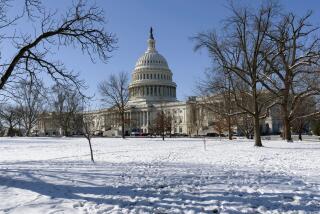House Approves $18.3-Billion S&L; Cleanup Bill : Thrifts: Narrow passage ends deadlock. Differences remain to be ironed out with Senate.
WASHINGTON — Overcoming 18 months of partisan deadlock, the House on Tuesday narrowly approved the expenditure of $18.3 billion to safeguard depositors and complete the cleanup of the savings and loan industry.
The 214-208 vote authorized the Resolution Trust Corp. to resume acquiring, selling and closing failed S&Ls--a; task that was halted April 1, 1992, by a previous act of Congress. Under the terms of the House bill, the RTC’s role would end on March 31, 1995.
The bill would authorize another $8 billion under certain conditions to help the industry offset future losses through 1998 if a private insurance fund is insufficient to protect depositors.
Although the bill was sent to a Senate-House conference to reconcile differences with a Senate version, backers of the measure said congressional approval of the final measure is virtually assured.
Rep. Stephen L. Neal (D-N.C.), floor manager for the bill, said the much-criticized RTC has protected 22 million depositors against losses in 657 failed S&Ls; so far. Another 170 thrifts are likely to be liquidated.
“RTC legislation never has been popular, but it appears this legislation will be the last needed to resolve the savings and loan debacle of the 1980s,” Neal told the House.
Opponents said the RTC already has enough money on hand or could raise funds through borrowing or selling off assets of closed S&Ls.;
Neal countered that Congress must release the $18.3 billion that was previously approved but never spent because of the 1992 deadline that effectively shut down RTC takeovers of financially weak thrifts.
If the funds were withheld, Neal added, the government would be breaking its promise to protect bank and savings deposits, potentially triggering a banking crisis worse than that which occurred during the Depression of the 1930s.
Advocates of the bill also said the RTC is now forced to operate about 80 S&Ls; at a loss--amounting to $3 million a day or about $1 billion a year--because Congress had barred it from spending any money to close failed S&Ls; or sell them to pay off depositors.
Similar RTC funding measures were rejected twice by the House in 1992 in response to requests from then-President George Bush. At the time, many Democrats withheld support, contending that too few Republicans were willing to vote for the unpopular spending bill.
This time, however, key Republicans on the House Committee on Banking, Finance and Urban Affairs worked out a compromise with the Democratic majority that attracted sufficient GOP support to squeak the bill through by a six-vote margin. The most significant element of the compromise was to reduce spending to offset future losses from a proposed $16 billion to $8 billion.
While 190 Democrats and 24 Republicans voted for the measure, 148 Republicans, 59 Democrats and one independent opposed it. One member abstained, 11 others did not vote and there is one vacancy in the 435-member House.
In the past, Democrats blamed former President Ronald Reagan for advocating financial deregulation that allowed savings associations to pay double-digit interest rates to depositors and then seek high returns from high-risk real estate ventures.
Ultimately, when many real estate loans went sour, government insurance programs had to pay off depositors when many savings associations became insolvent.
More to Read
Get the L.A. Times Politics newsletter
Deeply reported insights into legislation, politics and policy from Sacramento, Washington and beyond. In your inbox three times per week.
You may occasionally receive promotional content from the Los Angeles Times.










